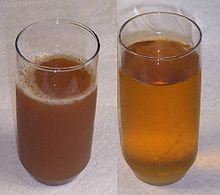**Nomenclature and Classification:**
– In North America, apple cider refers to unfiltered, unsweetened, non-alcoholic apple beverage.
– Hard cider is the term used for the alcoholic version.
– Some U.S. states differentiate between raw cider and processed apple juice.
– Massachusetts distinguishes fresh cider from cooked, filtered apple juice.
– Canada recognizes unfiltered, unsweetened apple juice as cider.
**Production Methods:**
– Modern cider making involves electric-hydraulic equipment.
– Early production methods included manual crushers and screw presses.
– Palmer Bros. Company made popular rack and cloth presses in the 1800s.
– Rotary drum scratters and electric hammermill breakers are used today.
– About one-third of a bushel of apples makes a gallon of cider.
**Varieties and Processing:**
– Historically, all cider was raw and unprocessed.
– Airborne yeasts on apple skins would start fermentation.
– Modern refrigeration slowed down fermentation.
– Traditional cider is made from a blend of apple varieties.
– Unpasteurized cider may become slightly carbonated and eventually hard cider.
**Treatment and Preservation:**
– Many commercial ciders are pasteurized or contain preservatives.
– Pasteurization changes sweetness, body, and flavor.
– UV radiation is also used for treatment.
– Federal regulations in the U.S. and Canada address cider safety.
– FDA requires juice producers to follow HACCP controls for pathogen reduction.
**Consumption and Cultural Significance:**
– Fresh cider is extracted from the whole apple, including core and trimmings.
– Cider is opaque due to fine apple particles in suspension.
– Pasteurization or UV light may be used to extend shelf life.
– Some companies add preservatives and boil cider for shelf stability.
– Apple cider is traditionally served on holidays like Halloween and Thanksgiving.
Apple cider (also called sweet cider, soft cider, or simply cider) is the name used in the United States and Canada for an unfiltered, unsweetened, non-alcoholic beverage made from apples. Though typically referred to simply as "cider" in North America, it is not to be confused with the alcoholic beverage known as cider in other places, which is called "hard cider" in the US. Outside of the United States and Canada, it is commonly referred to as cloudy apple juice to distinguish it from clearer, filtered apple juice and hard cider.

Fresh liquid cider is extracted from the whole apple itself, including the apple core, trimmings from apples, and oddly sized or shaped “imperfect” apples, or apple culls. Fresh cider is opaque due to fine apple particles in suspension and generally tangier than commercially cooked and filtered apple juice, but this depends somewhat on the variety of apples used. Cider is sometimes pasteurized or exposed to UV light to kill bacteria and extend its shelf life, but traditional raw untreated cider is still common. Some companies have begun adding preservatives and boiling cider, so that it can be shelf stable and stored without refrigeration. In either form, apple cider is seasonally produced in autumn. It is traditionally served on Halloween, Thanksgiving, Christmas, and New Year's Eve, sometimes heated and mulled.
